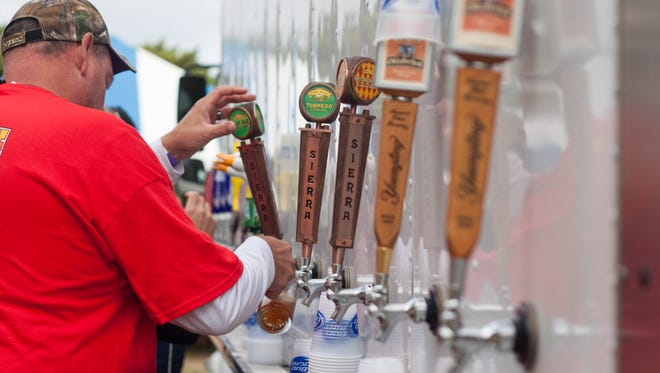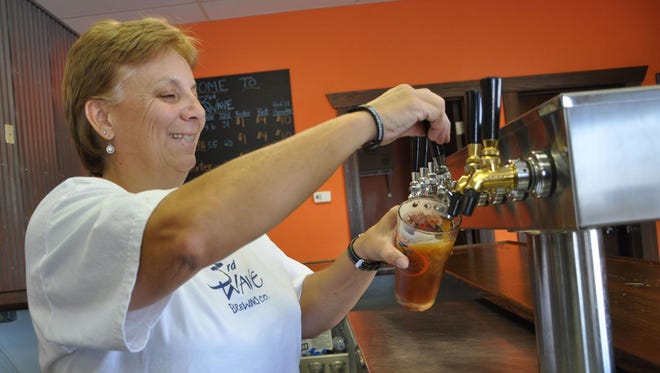Russo: Beer trends on the rise and fall in 2018

For people who aren’t immersed in it, craft beer trends can be sneaky.
For example, last summer all of a sudden people seemed to be drinking a lot of sour beers in cans. It didn’t come out of nowhere, though. Trends in beer, as in any other industry, rise and fall with tastes.
Brewers constantly try new things to see if they will stick, sometimes they do and sometimes they don’t.
If you want to know what’s on the rise, just ask at your local brewery and they’ll be happy to tell you.
In what follows, four local brewers talk about what they would like to see, which is different from what definitely will come to pass. Each of them spoke about what they see for the industry.
Crooked Hammock head brewer Chris Wright looks forward to more sour beers. Sour beers pretty much owned last summer and even pushed through the fall. Since sour beers can be tricky to do right, he said he hopes to see even more breweries get better at it.
Along those lines, Wright thinks niche brewing, breweries tending to specialize in one particular style of beer, could be on the rise.
“I see traditional styles getting more recognition from the new craft beer drinker once they've tired of the extreme or new styles,” he said. “The marzen, kolsch, bocks and even the spirited craft pilsner are something to truly be enjoyed if done well.”

Wright said he would like to see the trend of making high alcohol beers in low alcohol styles fall by the wayside in 2018.
“Imperial” is used to describe a beer that’s pretty high in alcohol. A trend over the last year was to have an imperial beer that traditionally was low in alcohol. For example, a Gose beer (kind of a salty sour) usually is in the 4 percent range, last summer saw lots of Imperial Gose beers in the 8 percent range.
“If I see an Imperial Gose ... just shoot me,” he said.

Lori Clough, who owns 3rd Wave Brewing, sees IPA variations continuing with the addition of different fruits to distinguish one from the other, especially in the first part of the year. For the summer, she sees sours getting even bigger.
“Everyone always wants something new, it is very hard to predict what someone will want to drink this time next year,” she said. “It would be cool to be able to though.”
By fall, Clough said she expects a fall-off in the super spicy beers that were pretty popular this year. Pumpkin spice beers found their level, and this fall and winter other variations came to the fore. But, she sees them receding as people continue to find “their beer.”
“In my opinion, as more people drink craft beer, the many different styles will each continue to grow in some way,” she said.
Mike Piorunski, head brewer at Evolution Craft Brewing in Salisbury, hopes 2018 brings him more beers that he can drink more of.

A few years ago, low-alcohol session IPAs became trendy. Increasingly and especially with the rise of cans, other low alcohol beers have come to the fore, which is something Piorunski sees more of in the future.
“I just find myself looking for high-quality, full-flavored low-gravity options,” he said. “I also hope brewers continue to push boundaries with beers infused with botanicals.”
One of the rising trends he hopes to see fade in the coming year are what some people call “pastry stouts.” These are dark beers that tend to be very sweet, geared more at being dessert than accompanying it.
“If things were my way, overly sweet beers like dessert stout and some 'so-called' milkshake IPAs would never see the bottom of a pint glass or pounder can ever again,” he said. “I like my beers to be dry, fully attenuated even the strong ones. That doesn't mean they should lack body, but there's no good reason a beer should taste like syrup with hops or dark malt.”
Burke Morrison, from Twin Lakes Brewing, doesn’t necessarily see the race to the top for highly-hopped beers going away, but feels as if it at least is beginning to plateau.

“There is definitely a subculture within the craft beer community that is experiencing pallet fatigue, and malt-forward and darker styles are re-gaining traction,” he said.
Twin Lakes has been in something of a transition while changing brewing locations and has leaned heavily on its festival appearances to get the word about its beers out. Morrison said that their Tweeds Tavern Stout was popular even in the summer as an alternative to heavily-hopped beers.
For 2018, he said he hoped to see fewer breweries chasing trends altogether.
“The myriad styles, flavors and aromas out there in the beer world are too great and diverse for everyone to be making the same styles,” he said.

For this author’s part, I think 2018 will see the rise of the brewpub as restaurants continue to expand to add small brewing facilities and house beers (as Gary’s Beach Grill recently did). Similarly, food trucks will turn production breweries into destinations.
I think the acquisition of smaller breweries by larger ones will flatline in the coming year, making it less profitable for people to start breweries in the hope of being acquired. In 2017, there were about 6,000 breweries. I don’t think that number will be too much higher at the end of 2018.